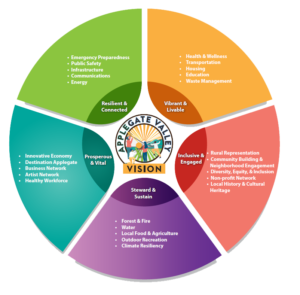15 listening sessions, a 90-page plan, and 500 steps for action. Megan Fehrman explains.
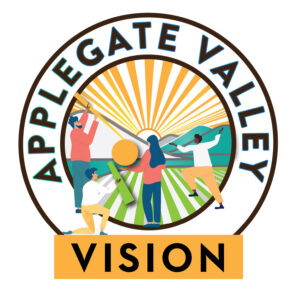
No one has their finger on the pulse of the Applegate more than Megan Fehrman. Over the past three years, she has led listening sessions in over 15 different “neighborhoods” and other groups in the Applegate Valley. This undertaking was part of A Greater Applegate’s core mission: to support the economic, environmental and social vitality of our area. Megan has been working as the Director of Vision Strategy and recently moved into the role of co-Executive Director with Seth Kaplan.
During the sessions, Megan and her team posed a variety of questions—including what people loved about life here and what concerned them. She recorded the answers, looked for patterns, and included them in the Applegate Valley Vision, a 90-page guide to the actions needed to make our collective vision of the future happen. It is being released to the community this September.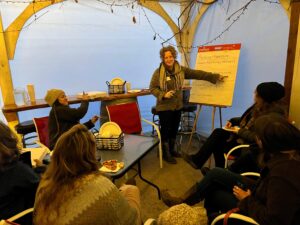
Megan has a strong background in rural community building. She has worked for years as a community organizer, earned a certificate in the subject from Oregon State University, and was recently recognized by Tucker Teutsch as an “Exceptional Rural Community Builder”.
We met one hot, August afternoon under the new seating area that was added to Code 3 Coffee Drive-thru in Ruch’s Sunshine Plaza. It was an apt place to meet up: A desire for more public gathering spaces was frequently expressed during listening sessions. Megan was careful and articulate when discussing the Vision Project. It was clear that she takes communication seriously.
Why are listening sessions and creating a vision plan important?
We live in a place with little jurisdiction. In some sense, that is an asset, because it means as a community, we get to decide what we want to do. But it’s also a challenge because we have no tax base and a lot of the money that gets extracted out of here doesn’t come back.
Natural resource extraction has been a mainstay of rural communities all over Oregon for a long time, and some of that was repaid  through jobs. But a lot of that has changed because of mechanization and efficiencies and trees running out—and, of course, some would say the environmental resistance.
through jobs. But a lot of that has changed because of mechanization and efficiencies and trees running out—and, of course, some would say the environmental resistance.
So now there’s just this sense of: “What happens next?” “What do rural communities do?” The listening sessions address these shifts and questions.
Before your work with A Greater Applegate, you conducted some listening sessions with farmers and ranchers as part of a state-wide project. But more recently, organized informal listening sessions with your Little Applegate neighborhood. Tell me about that.
I worked with a couple of neighbors to organize meetings and do asset mapping for our area. Over the course of three meetings, we looked at everything we had, from ponds and infrastructure that might help in an emergency, to historic and cultural sites, to services that people could offer one another—say, massage, healthcare or herbalism, drawing or drafting plans. Things like that.
It was a really fun way to bring the neighborhood together.
How did these sessions lead to your work with A Greater Applegate?
I had reached out to the Ford Family Foundation and said , “Hey I did this thing in the Little Applegate” and applied for one of their grants to hold these kinds of meetings in more neighborhoods around here.
They referred me to Seth Kaplan, who was the board chair at the time. He was trying to enliven the organization after it had been released from managing Cantrall-Buckley. When the county took the park management back, AGA got a new lease on life. They got to revisit their mission and vision.
Seth and I had a meeting and he asked me to be on the board of AGA. I agreed and we did some strategic planning.
Is this where the idea of AGA’s Listening Sessions was born?
Yes. At some point we realized the only way we were going to reach people was to go where they were–that’s Community Organizing 101—go to where the people are! Then ask them: What do you love about this place? What assets do we have? What opportunities are there to build on what we have here? Where are there challenges? What are the gaps? 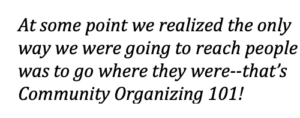
It was the right place, at the right time, with the right people. Seth was here trying to regenerate the organization, funding came along from The Ford Family Foundation, and I had the interest.
How did you reach out to get people to participate in the listening sessions?
We got the word out both electronically, and in other ways. We published announcements in the Applegater, put flyers on all the bulletin boards, sent emails, made Facebook posts, included it in AGA’s bi-weekly newsletter. We encouraged word-of-mouth.
We tried to schedule the meetings at a variety of venues at times when most people were available, offered dinner and childcare. Some meetings there were five people and some meetings there were 40. We had to be prepared for either option. 
Were there things that surprised you?
The listening sessions were all unique in the characters–and the character–of the discussions, but there certainly were themes that showed up in every meeting. A lot of those themes show up in The Vision: Road safety, mail theft concerns, wildfire, Internet access. And we all know Highway 238 is a concern.
I think more than being surprised it was just kind of a delightful experience. I learned the nuances of all these little nooks and crannies we have here, but also saw there is a common experience and common needs. We have things we can share across neighborhoods. Little Applegate is a great example of having developed an emergency text tree. The folks at Thompson creek manage an irrigation ditch together.
What did people love about the Applegate?
One thing that stood out was the love of the landscape, the beauty and the rivers and creeks and waterways and the biodiversity and the wildlife—those things came up over and over again. It felt universal.
It was clear that nobody wants to change our rural character. The question was how do we make it better and more functional for people to be able to live here, and to make a living honestly. If you are retired and you don’t have to worry about that, that’s one thing, but what  happens to the community if we don’t have a diverse set of ages and families who can live and work here? If we don’t have that kind of thread through the generations?
happens to the community if we don’t have a diverse set of ages and families who can live and work here? If we don’t have that kind of thread through the generations?
Folks love their local businesses, farms and the food. If we want these things to survive, we have to make sure we are doing the things that will support that.
Did any challenge stand out the most?
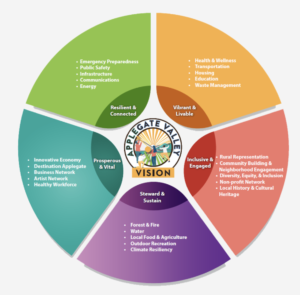 Of course, Internet access is one thing, but it was not by far and away the only thing. I think having a safe community was high on the list. There’s certainly some feeling that the Applegate isn’t as safe as it used to be. We want to know each other and trust each other, and I think that is still true, but there are certainly some noticeable things to pay attention to.
Of course, Internet access is one thing, but it was not by far and away the only thing. I think having a safe community was high on the list. There’s certainly some feeling that the Applegate isn’t as safe as it used to be. We want to know each other and trust each other, and I think that is still true, but there are certainly some noticeable things to pay attention to.
Did you encounter any resistance to The Vision process?
There is always going to be a portion of people who resist any kind of organizing. In rural places in general, I imagine there is just a segment of the population that wants to be left alone. And that’s fine. Those aren’t the people that would be involved in something like this because they don’t want to be. But they are not excluded. They are welcome to participate.
There isn’t anything we are doing that is coming down on partisan lines. This is all about what people enjoy about living here, and how we can make it better, and maybe overcome some of the challenges that we are facing. There are a myriad of ideas on those topics. There is something in there for everyone, and if have the curiosity to look at The Vision, you’ll probably find something that you think: Oh hey, that’s a pretty good idea!
Do you see any trends?
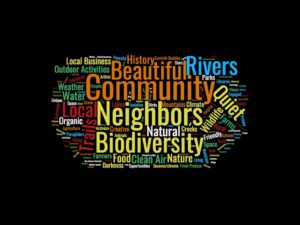 The Applegate is such a unique rural space. We cross three counties–one of them being in another state: Siskiyou county. Rural community data is usually collected at the country level, so it’s just really hard to narrow in on themes.
The Applegate is such a unique rural space. We cross three counties–one of them being in another state: Siskiyou county. Rural community data is usually collected at the country level, so it’s just really hard to narrow in on themes.
But it’s clear that we are definitely an aging population. The income seems to be trending up—not because actual earned incomes are going up—but rather people are arriving here with more money. There is more home ownership, but less rentals. A lot of people can’t afford to live here anymore.
I think visitors are coming more than they used to be, and so we as a community need to decide how we manage that so that it doesn’t get out of control–as we’ve seen it happen in so many other places.
Would you see AGA as a Chamber of Commerce of sorts?
That would definitely be a mischaracterization. We are working on the issue of Destination Management because we feel it’s important to be able to balance visitors coming here with what the community wants. We are not promoting tourism in the area.
That said, there is some part of that could be seen as an economic driver for rural areas. We do run a network for our local businesses to come together and learn from each other. We try to provide some technical assistance. So, while we are not a Chamber, we do want to see economic and social environment where the Applegate is thriving. 
We want the people who live here to be able to find the goods and services they need so that everyone doesn’t have to go to town for everything. We can support each other.
For Applegate residents that missed the listening sessions, is it too late?
Definitely not too late! This is really only just beginning in a lot of ways. We’ve gathered a lot of input in making this plan. But from here on out, we need people to help carry this forward.
And so there will be working groups and community action teams on different pieces of The Vision plan. There are over 500 different actions suggested in The Vision!
There will be lots of information about how to get involved coming out in the Applegater, A Greater Applegate’s website, the Applegate Valley Connect website and AGA’s bi-weekly bulletin.
Perfect day?
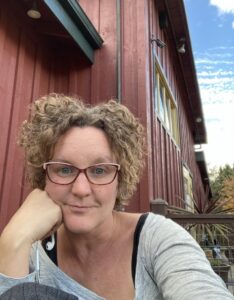 I live at the confluence of Yale Creek and little Applegate so there’s a really nice little spot down there to have tea in the morning–or cocktails depending on the time of day. After tea, I probably go for a walk on the Sterling Mine Ditch Trail or maybe the East ART trail. And then, of course, that would probably be followed by a swim in the river.
I live at the confluence of Yale Creek and little Applegate so there’s a really nice little spot down there to have tea in the morning–or cocktails depending on the time of day. After tea, I probably go for a walk on the Sterling Mine Ditch Trail or maybe the East ART trail. And then, of course, that would probably be followed by a swim in the river.
If we were lucky, and one of the wineries had music that evening or a supper club, I go have a glass of wine and listen to music and have something to eat. And if we are double lucky and its clear –as it usually is –it’s nice to sit back out on the porch and see some stars.
Advice to anyone who just moved here?
The Applegate Valley Connect calendar is a really good place to start getting a sense of what is going on here. The Applegate Country Club tends to be pretty social. They have different nights where they have music. It’s just a good place to go you can chat to somebody next to you. Same with the deck at The Applegate River Lodge when they have things going on.
I also recommend getting to know your neighbors in a positive way. I think that’s really an important part of rural life. They may be the people you need to call if you get a flat tire, or if your lawn mower breaks.
A Greater Applegate does have a lot of working group meetings. We have business and nonprofit networks and we have artists’ network. The meetings tend to be interesting and fun. There are also lots of nonprofits and projects with volunteer opportunities.
Do you ever feel like you are missing out, not being in the city? Any grass-is-greener feelings?
I don’t miss urban life. I feel very held by this community, and I obviously have good work that feels meaningful. I have a lot of friends and social activities going on. There’s plenty to do!
Although there is one segment of the population that seems to be missing: Young couples and families, 30-40-year old singles. It did come up in the Vision plan! I’m not the only one that feels that way!
View the complete Applegate Valley Vision plan here.
